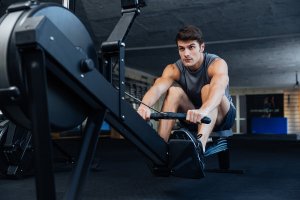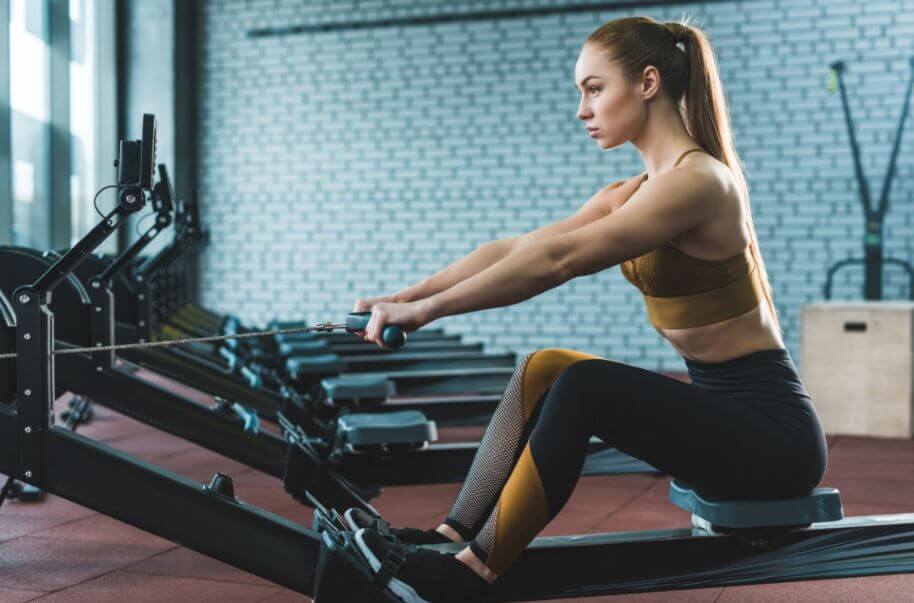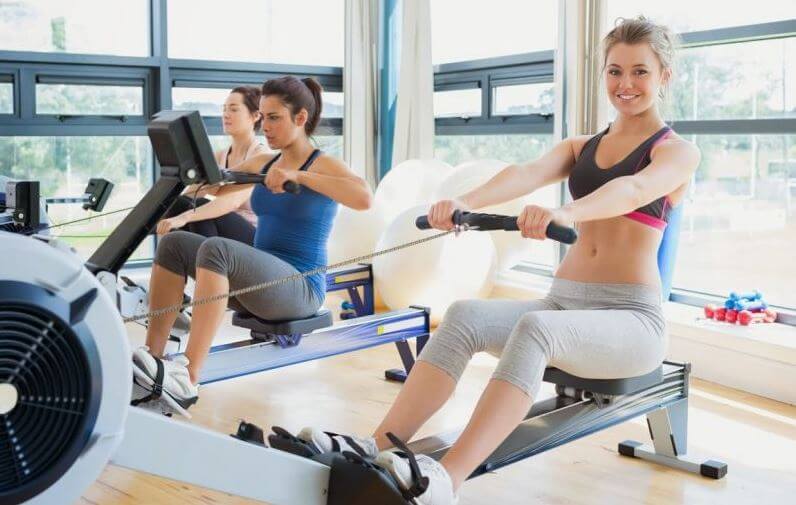Training with the Rowing Machine

Training with rowing machines is becoming more and more popular in the fitness world. These machines offer an integral exercise without impacting the knees. The main goal is to strengthen the abdominals, buttocks, quadriceps, hamstrings and other muscles of the body.
There are two types of equipment for indoor rowing:
- Static machines: available in most gyms.
- Machines that use the force of water to generate resistance.
These exercises find their origins in traditional rowing such as is practiced in kayaks, canoes and boats. However, due to the hectic pace of modern life, rowing outdoors three or four times a week is impossible for most people.
Thanks to their design, these machines simulate real rowing action. This helps replicate the enormous list of benefits that outdoor rowing provides.
Row!
Rowing can workout almost all of the body’s muscles. It’s an integral endurance activity. In addition, it doesn’t cause a lot of impact on the joints. This makes it almost impossible to suffer from injuries unless you apply improper techniques.
This is the ideal exercise for rehabilitation since it will allow you to rebuild strength and muscle tone. It will also allow you to progressively increase mobility and flexibility.
It’s also an excellent cardiovascular exercise. The heart rate increases gradually and this will allow you to maintain the pace of the activity for longer periods of time without negatively affecting your body.
Rowing is a very efficient way to burn calories. In the same way, it can help strengthen your back by working out the stabilizing and postural muscles.

Group training with rowing machines
Nowadays, rowing has gained as much popularity as spinning. This is thanks to the fact that it’s an activity that can be performed collectively.
In many cases, working out in a group is more effective than working out individually. The challenge to not be the slowest in the class can be a great motivator.
Like walking, rowing is completely natural. Therefore, adopting proper techniques does not require a lot of time. With the right advice, one session will be enough to teach you how to proceed.
Rowing: more than just pushing and pulling
Each training session can be organized according to distance patterns or according to intensity. However, beyond these parameters, the movements performed during rowing can be divided into three phases:
- The catch: this is the starting point. Your legs should be completely bent and your arms extended forwards.
- The drive: extend your legs while simultaneously pulling the handle with your hands close to your chest.
- Recovery: back to the starting position. First, extend your arms and then bend your knees. All of the transitions should be carried out as smoothly as possible.
Rowing machines and traditional rowing: differences
Training with machines can be more enjoyable and entertaining. These machines will allow you to feel as if you were outdoors while offering you the comfort of the gym.
There are tools that can be adjusted to your specific needs. Exercises on static equipment require less effort since they don’t have the natural resistance generated by water.

Common mistakes made on the rowing machine
The most common mistake when performing exercises on these machines is not taking care of the back. If your back is not kept completely straight, the workout will not be focused on the upper body.
Other common mistakes include:
- Holding on to the handle with hands too close together.
- Flexing wrist.
- Sitting with knees apart.
- Making rushed movements.
In conclusion, exercises performed with these machines should be carried out calmly and patiently. It’s also important to carry out the exercises with the proper technique. Rushing and not paying attention could cause injuries and other complications.
Training with rowing machines is becoming more and more popular in the fitness world. These machines offer an integral exercise without impacting the knees. The main goal is to strengthen the abdominals, buttocks, quadriceps, hamstrings and other muscles of the body.
There are two types of equipment for indoor rowing:
- Static machines: available in most gyms.
- Machines that use the force of water to generate resistance.
These exercises find their origins in traditional rowing such as is practiced in kayaks, canoes and boats. However, due to the hectic pace of modern life, rowing outdoors three or four times a week is impossible for most people.
Thanks to their design, these machines simulate real rowing action. This helps replicate the enormous list of benefits that outdoor rowing provides.
Row!
Rowing can workout almost all of the body’s muscles. It’s an integral endurance activity. In addition, it doesn’t cause a lot of impact on the joints. This makes it almost impossible to suffer from injuries unless you apply improper techniques.
This is the ideal exercise for rehabilitation since it will allow you to rebuild strength and muscle tone. It will also allow you to progressively increase mobility and flexibility.
It’s also an excellent cardiovascular exercise. The heart rate increases gradually and this will allow you to maintain the pace of the activity for longer periods of time without negatively affecting your body.
Rowing is a very efficient way to burn calories. In the same way, it can help strengthen your back by working out the stabilizing and postural muscles.

Group training with rowing machines
Nowadays, rowing has gained as much popularity as spinning. This is thanks to the fact that it’s an activity that can be performed collectively.
In many cases, working out in a group is more effective than working out individually. The challenge to not be the slowest in the class can be a great motivator.
Like walking, rowing is completely natural. Therefore, adopting proper techniques does not require a lot of time. With the right advice, one session will be enough to teach you how to proceed.
Rowing: more than just pushing and pulling
Each training session can be organized according to distance patterns or according to intensity. However, beyond these parameters, the movements performed during rowing can be divided into three phases:
- The catch: this is the starting point. Your legs should be completely bent and your arms extended forwards.
- The drive: extend your legs while simultaneously pulling the handle with your hands close to your chest.
- Recovery: back to the starting position. First, extend your arms and then bend your knees. All of the transitions should be carried out as smoothly as possible.
Rowing machines and traditional rowing: differences
Training with machines can be more enjoyable and entertaining. These machines will allow you to feel as if you were outdoors while offering you the comfort of the gym.
There are tools that can be adjusted to your specific needs. Exercises on static equipment require less effort since they don’t have the natural resistance generated by water.

Common mistakes made on the rowing machine
The most common mistake when performing exercises on these machines is not taking care of the back. If your back is not kept completely straight, the workout will not be focused on the upper body.
Other common mistakes include:
- Holding on to the handle with hands too close together.
- Flexing wrist.
- Sitting with knees apart.
- Making rushed movements.
In conclusion, exercises performed with these machines should be carried out calmly and patiently. It’s also important to carry out the exercises with the proper technique. Rushing and not paying attention could cause injuries and other complications.
All cited sources were thoroughly reviewed by our team to ensure their quality, reliability, currency, and validity. The bibliography of this article was considered reliable and of academic or scientific accuracy.
- Mäestu, J., Jürimäe, J., & Jürimäe, T. (2005). Monitoring of performance and training in rowing. Sports Medicine. https://doi.org/10.2165/00007256-200535070-00005
- García-Pallars, J., & Izquierdo, M. (2011). Strategies to optimize concurrent training of strength and aerobic fitness for rowing and canoeing. Sports Medicine. https://doi.org/10.2165/11539690-000000000-00000
- Gee, T. I., Olsen, P. D., Berger, N. J., Golby, J., & Thompson, K. G. (2011). Strength and conditioning practices in rowing. Journal of Strength and Conditioning Research, 25(3), 668–682. https://doi.org/10.1519/JSC.0b013e3181e2e10e
This text is provided for informational purposes only and does not replace consultation with a professional. If in doubt, consult your specialist.








